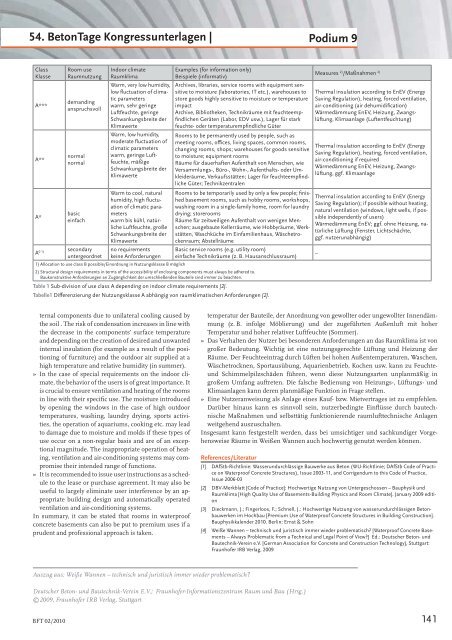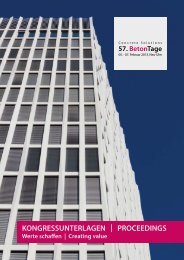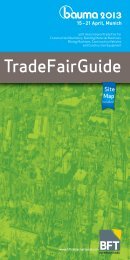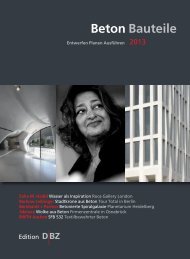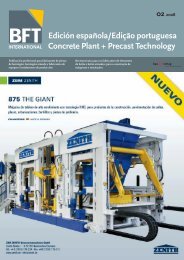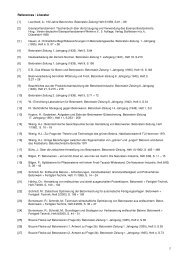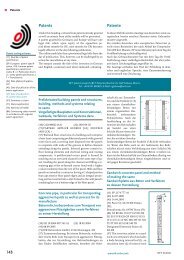Concrete Plant + Precast Technology Betonwerk ... - BFT International
Concrete Plant + Precast Technology Betonwerk ... - BFT International
Concrete Plant + Precast Technology Betonwerk ... - BFT International
Sie wollen auch ein ePaper? Erhöhen Sie die Reichweite Ihrer Titel.
YUMPU macht aus Druck-PDFs automatisch weboptimierte ePaper, die Google liebt.
54. BetonTage Kongressunterlagen |<br />
Class<br />
Klasse<br />
A***<br />
A**<br />
A*<br />
0 1) secondary<br />
A<br />
ternal components due to unilateral cooling caused by<br />
the soil . The risk of condensation increases in line with<br />
the decrease in the components’ surface temperature<br />
and depending on the creation of desired and unwanted<br />
internal insulation (for example as a result of the positioning<br />
of furniture) and the outdoor air supplied at a<br />
high temperature and relative humidity (in summer).<br />
» In the case of special requirements on the indoor climate,<br />
the behavior of the users is of great importance. It<br />
is crucial to ensure ventilation and heating of the rooms<br />
in line with their specifi c use. The moisture introduced<br />
by opening the windows in the case of high outdoor<br />
temperatures, washing, laundry drying, sports activities,<br />
the operation of aquariums, cooking etc. may lead<br />
to damage due to moisture and molds if these types of<br />
use occur on a non-regular basis and are of an exceptional<br />
magnitude. The inappropriate operation of heating,<br />
ventilation and air-conditioning systems may compromise<br />
their intended range of functions.<br />
» It is recommended to issue user instructions as a schedule<br />
to the lease or purchase agreement. It may also be<br />
useful to largely eliminate user interference by an appropriate<br />
building design and automatically operated<br />
ventilation and air-conditioning systems.<br />
In summary, it can be stated that rooms in waterproof<br />
concrete basements can also be put to premium uses if a<br />
prudent and professional approach is taken.<br />
<strong>BFT</strong> 02/2010<br />
Room use<br />
Raumnutzung<br />
demanding<br />
anspruchsvoll<br />
normal<br />
normal<br />
basic<br />
einfach<br />
untergeordnet<br />
Indoor climate<br />
Raumklima<br />
Warm, very low humidity,<br />
low fl uctuation of climatic<br />
parameters<br />
warm, sehr geringe<br />
Luftfeuchte, geringe<br />
Schwankungsbreite der<br />
Klimawerte<br />
Warm, low humidity,<br />
moderate fl uctuation of<br />
climatic parameters<br />
warm, geringe Luftfeuchte,<br />
mäßige<br />
Schwankungsbreite der<br />
Klimawerte<br />
Warm to cool, natural<br />
humidity, high fl uctuation<br />
of climatic parameters<br />
warm bis kühl, natürliche<br />
Luftfeuchte, große<br />
Schwankungsbreite der<br />
Klimawerte<br />
no requirements<br />
keine Anforderungen<br />
Examples (for information only)<br />
Beispiele (informativ)<br />
Archives, libraries, service rooms with equipment sensitive<br />
to moisture (laboratories, IT etc.), warehouses to<br />
store goods highly sensitive to moisture or temperature<br />
impact<br />
Archive, Bibliotheken, Technikräume mit feuchteempfi<br />
ndlichen Geräten (Labor, EDV usw.), Lager für stark<br />
feuchte- oder temperaturempfi ndliche Güter<br />
Rooms to be permanently used by people, such as<br />
meeting rooms, offi ces, living spaces, common rooms,<br />
changing rooms, shops; warehouses for goods sensitive<br />
to moisture; equipment rooms<br />
Räume für dauerhaften Aufenthalt von Menschen, wie<br />
Versammlungs-, Büro-, Wohn-, Aufenthalts- oder Umkleideräume,<br />
Verkaufsstätten; Lager für feuchteempfi ndliche<br />
Güter; Technikzentralen<br />
Rooms to be temporarily used by only a few people; fi nished<br />
basement rooms, such as hobby rooms, workshops,<br />
washing room in a single-family home, room for laundry<br />
drying; storerooms<br />
Räume für zeitweiligen Aufenthalt von wenigen Menschen;<br />
ausgebaute Kellerräume, wie Hobbyräume, Werkstätten,<br />
Waschküche im Einfamilienhaus, Wäschetrockenraum;<br />
Abstellräume<br />
Basic service rooms (e.g. utility room)<br />
einfache Technikräume (z. B. Hausanschlussraum)<br />
1) Allocation to use class B possible/Einordnung in Nutzungsklasse B möglich<br />
2) Structural design requirements in terms of the accessibility of enclosing components must always be adhered to.<br />
Baukonstruktive Anforderungen an Zugänglichkeit der umschließenden Bauteile sind immer zu beachten.<br />
Table 1 Sub-division of use class A depending on indoor climate requirements [2].<br />
Tabelle1 Diff erenzierung der Nutzungsklasse A abhängig von raumklimatischen Anforderungen [2].<br />
Auszug aus: Weiße Wannen – technisch und juristisch immer wieder problematisch?<br />
Deutscher Beton- und Bautechnik-Verein E.V.; Fraunhofer-Informationszentrum Raum und Bau (Hrsg.)<br />
©2009, Fraunhofer IRB Verlag, Stuttgart<br />
Podium 9<br />
Measures 2) /Maßnahmen 2)<br />
Thermal insulation according to EnEV (Energy<br />
Saving Regulation), heating, forced ventilation,<br />
air-conditioning (air dehumidifi cation)<br />
Wärmedämmung EnEV, Heizung, Zwangslüftung,<br />
Klimaanlage (Luftentfeuchtung)<br />
Thermal insulation according to EnEV (Energy<br />
Saving Regulation), heating, forced ventilation,<br />
air-conditioning if required<br />
Wärmedämmung EnEV, Heizung, Zwangslüftung,<br />
ggf. Klimaanlage<br />
Thermal insulation according to EnEV (Energy<br />
Saving Regulation); if possible without heating,<br />
natural ventilation (windows, light wells, if possible<br />
independently of users)<br />
Wärmedämmung EnEV; ggf. ohne Heizung, natürliche<br />
Lüftung (Fenster, Lichtschächte,<br />
ggf. nutzerunabhängig)<br />
–<br />
temperatur der Bauteile, der Anordnung von gewollter oder ungewollter Innendämmung<br />
(z. B. infolge Möblierung) und der zugeführten Außenluft mit hoher<br />
Temperatur und hoher relativer Luftfeuchte (Sommer).<br />
» Das Verhalten der Nutzer bei besonderen Anforderungen an das Raumklima ist von<br />
großer Bedeutung. Wichtig ist eine nutzungsgerechte Lüftung und Heizung der<br />
Räume. Der Feuchteeintrag durch Lüften bei hohen Außentemperaturen, Waschen,<br />
Wäschetrocknen, Sportausübung, Aquarienbetrieb, Kochen usw. kann zu Feuchte-<br />
und Schimmelpilzschäden führen, wenn diese Nutzungsarten unplanmäßig in<br />
großem Umfang auftreten. Die falsche Bedienung von Heizungs-, Lüftungs- und<br />
Klimaanlagen kann deren planmäßige Funktion in Frage stellen.<br />
» Eine Nutzeranweisung als Anlage eines Kauf- bzw. Mietvertrages ist zu empfehlen.<br />
Darüber hinaus kann es sinnvoll sein, nutzerbedingte Einfl üsse durch bautechnische<br />
Maßnahmen und selbsttätig funktionierende raumlufttechnische Anlagen<br />
weitgehend auszuschalten.<br />
Insgesamt kann festgestellt werden, dass bei umsichtiger und sachkundiger Vorgehensweise<br />
Räume in Weißen Wannen auch hochwertig genutzt werden können.<br />
References/Literatur<br />
[1] DAfStb-Richtlinie: Wasserundurchlässige Bauwerke aus Beton (WU-Richtlinie; DAfStb Code of Practice<br />
on Waterproof <strong>Concrete</strong> Structures), Issue 2003-11, and Corrigendum to this Code of Practice,<br />
Issue 2006-03<br />
[2] DBV-Merkblatt [Code of Practice]: Hochwertige Nutzung von Untergeschossen – Bauphysik und<br />
Raumklima [High Quality Use of Basements-Building Physics and Room Climate]. January 2009 edition<br />
[3] Dieckmann, J.; Fingerloos, F.; Schnell, J.: Hochwertige Nutzung von wasserundurchlässigen Betonbauwerken<br />
im Hochbau [Premium Use of Waterproof <strong>Concrete</strong> Structures in Building Construction].<br />
Bauphysikkalender 2010. Berlin: Ernst & Sohn<br />
[4] Weiße Wannen – technisch und juristisch immer wieder problematisch? [Waterproof <strong>Concrete</strong> Basements<br />
– Always Problematic from a Technical and Legal Point of View?] Ed.: Deutscher Beton- und<br />
Bautechnik-Verein e.V. [German Association for <strong>Concrete</strong> and Construction <strong>Technology</strong>], Stuttgart:<br />
Fraunhofer IRB Verlag, 2009<br />
141


